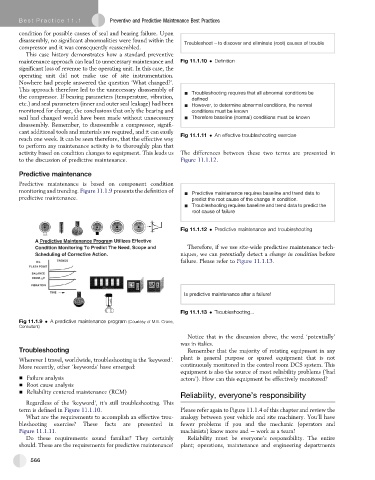Page 594 - Subyek Teknik Mesin - Forsthoffers Best Practice Handbook for Rotating Machinery by William E Forsthoffer
P. 594
Be st Practice 1 1.1 Preventive and Predictive Maintenance Best Practices
condition for possible causes of seal and bearing failure. Upon
disassembly, no significant abnormalities were found within the Troubleshoot – to discover and eliminate (root) causes of trouble
compressor and it was consequently reassembled.
This case history demonstrates how a standard preventive
maintenance approach can lead to unnecessary maintenance and Fig 11.1.10 Definition
significant loss of revenue to the operating unit. In this case, the
operating unit did not make use of site instrumentation.
Nowhere had people answered the question ‘What changed?’.
This approach therefore led to the unnecessary disassembly of Troubleshooting requires that all abnormal conditions be
the compressor. If bearing parameters (temperature, vibration, defined
etc.) and seal parameters (inner and outer seal leakage) had been However, to determine abnormal conditions, the normal
monitored for change, the conclusions that only the bearing and conditions must be known
seal had changed would have been made without unnecessary Therefore baseline (normal) conditions must be known
disassembly. Remember, to disassemble a compressor, signifi-
cant additional tools and materials are required, and it can easily Fig 11.1.11 An effective troubleshooting exercise
reach one week. It can be seen therefore, that the effective way
to perform any maintenance activity is to thoroughly plan that
activity based on condition changes to equipment. This leads us The differences between these two terms are presented in
to the discussion of predictive maintenance. Figure 11.1.12.
Predictive maintenance
Predictive maintenance is based on component condition
monitoring and trending. Figure 11.1.9 presents the definition of
Predictive maintenance requires baseline and trend data to
predictive maintenance. predict the root cause of the change in condition.
Troubleshooting requires baseline and trend data to predict the
root cause of failure
Fig 11.1.12 Predictive maintenance and troubleshooting
Therefore, if we use site-wide predictive maintenance tech-
niques, we can potentially detect a change in condition before
failure. Please refer to Figure 11.1.13.
Is predictive maintenance after a failure!
Fig 11.1.13 Troubleshooting...
Fig 11.1.9 A predictive maintenance program (Courtesy of M.E. Crane,
Consultant)
Notice that in the discussion above, the word ‘potentially’
was in italics.
Troubleshooting Remember that the majority of rotating equipment in any
Wherever I travel, worldwide, troubleshooting is the ‘keyword’. plant is general purpose or spared equipment that is not
More recently, other ‘keywords’ have emerged: continuously monitored in the control room DCS system. This
equipment is also the source of most reliability problems (‘bad
- Failure analysis actors’). How can this equipment be effectively monitored?
- Root cause analysis
- Reliability centered maintenance (RCM)
Reliability, everyone’s responsibility
Regardless of the ‘keyword’,it’s still troubleshooting. This
term is defined in Figure 11.1.10. Please refer again to Figure 11.1.4 of this chapter and review the
What are the requirements to accomplish an effective trou- analogy between your vehicle and site machinery. You’ll have
bleshooting exercise? These facts are presented in fewer problems if you and the mechanic (operators and
Figure 11.1.11. machinists) know more and e work as a team!
Do these requirements sound familiar? They certainly Reliability must be everyone’s responsibility. The entire
should. These are the requirements for predictive maintenance! plant; operations, maintenance and engineering departments
566

